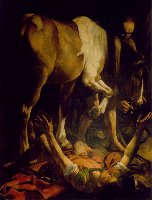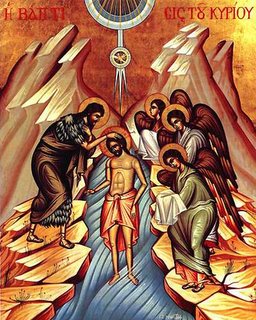Deus Caritas Est
 Deus Caritas Est (in English: God is Love) is the first encyclical written by Pope Benedict XVI. It was promulgated at 11:00 UTC on 25 January 2006 in Latin and in translations into seven other languages (English, French, German, Italian, Polish, Portuguese, and Spanish).
Deus Caritas Est (in English: God is Love) is the first encyclical written by Pope Benedict XVI. It was promulgated at 11:00 UTC on 25 January 2006 in Latin and in translations into seven other languages (English, French, German, Italian, Polish, Portuguese, and Spanish).Summary:
In this encyclical, Benedict reflects on the concepts of eros, agape, and logos, and their relationship with the teachings of Jesus. Agape is descending, ablative love in which one gives of oneself to another. Eros is ascending, possessive love which seeks to receive from another. The document explains that eros and agape are both inherently good, but that eros risks being downgraded to mere sex if it is not balanced by an element of spiritual Christianity. The opinion that eros is inherently good contrasts with the view expressed by Anders Nygren, a Lutheran bishop, in his mid-20th century book Eros and Agape, that agape is the only truly Christian kind of love, and that eros is an expression of the individual's desires and turns us away from God.[10] The continuity of these two forms of love follows the traditional Catholic understanding, which is influenced by the philosophy of Plato, Augustine, Bonaventure and ancient Jewish tradition. The encyclical is closer to the Caritas tradition in catholic theology as opposed to the Nygren position which emphasizes the differences between eros and agape. The Nygren position was favoured by the Reformed theologian Karl Barth while the Caritas position was supported by the liberal protestant theologian Paul Tillich. The two perspectives have been an ongoing debate in both Catholic and Protestant theology.
The first half of the encyclical is more philosophical, tracing the meaning of the Greek words for word "love". In considering eros, Benedict refers to a line from Virgil's Eclogues, Book X, line 69, "Omnia vincit amor, et nos cedamus amori" ("Love conquers all, let us also yield to love"), and the opinion of Friedrich Nietzsche that Christianity has poisoned eros, turning it into a vice. He refers to the conjugal love exhibited in the Song of Songs, and analyses passages from the First Letter of St. John which inspired the title. The encyclical argues that eros and agape are not distinct kinds of love, but are separate halves of complete love, unified as both a giving and receiving.
The second half, based on a report prepared by the Pontifical Council Cor Unum, is less abstract, considering the charitable activities of the Church as an expression of love, and referring to the Church's three-fold responsibility: proclaiming the word of God (kerygma-martyria), celebrating the sacraments (leitourgia), and exercising the ministry of charity (diakonia). The encyclical says that social justice is the primary responsibility of politics and the laity; the church itself should inform the debate on social justice with reason guided by faith, but its main social activity should be directed towards charity. Charity workers should have a deep prayer life, and be uninfluenced by party and ideology. Benedict rejects Marxist arguments that the poor "do not need charity but justice", and encourages cooperation between the church, the state, and other Christian charitable organizations.
Paragraph 39 appears to be inspired by Dante Alighieri's Divine Comedy, reflecting in particular the last canto of "Paradise", which ends before "the everlasting Light that is God himself, before that Light which at the same time is the love which moves the sun and the other stars".[11] The three concluding paragraphs consider the example of the saints, ending with a prayer to the Virgin Mary. The text mentions the name of Mother Teresa four times, the last as a "saint" (despite the fact that she has not yet been canonised) in such company as Francis of Assisi, Ignatius of Loyola, John of God, Camillus of Lellis, Vincent de Paul, Louise de Marillac, Giuseppe B. Cottolengo, John Bosco, and Luigi Orione.
Deus Caritas Est, like the encyclicals of many previous popes, uses the Royal we in the Latin text ("cupimus loqui de amore"). The versions in the other 7 languages use the singular ("I wish to speak of love").
source: from Wikipedia, the free encyclopedia








